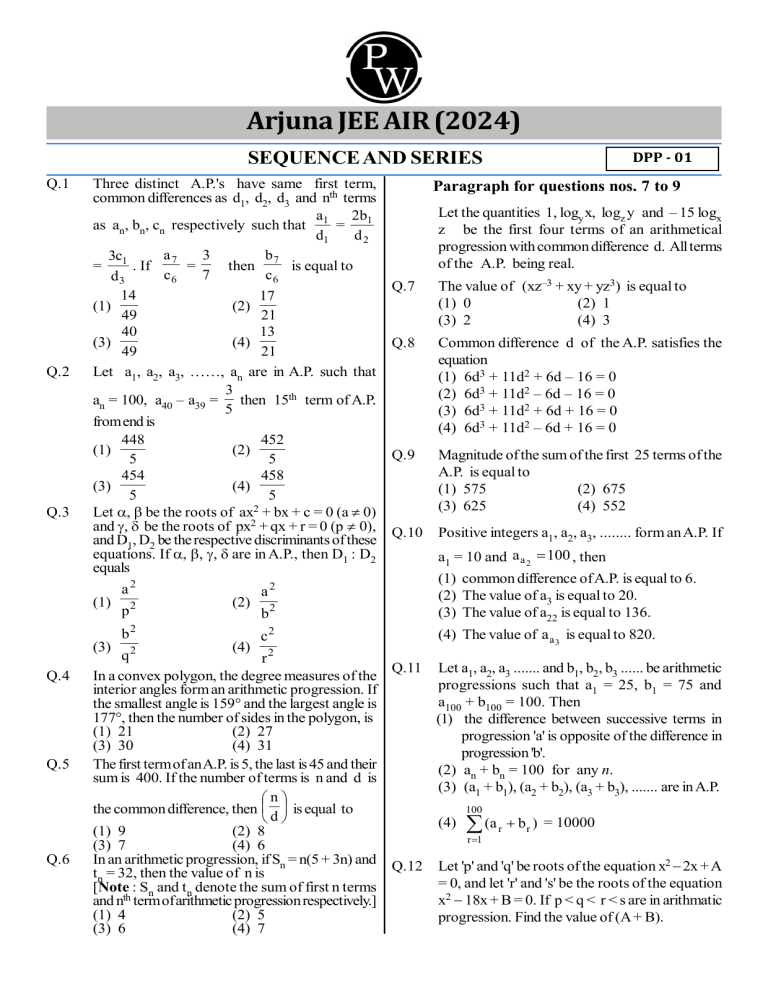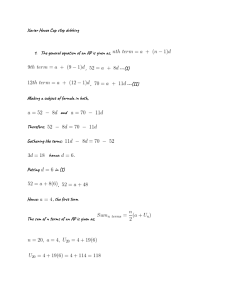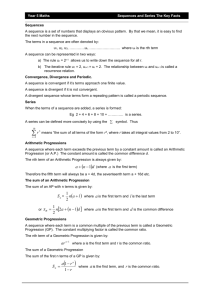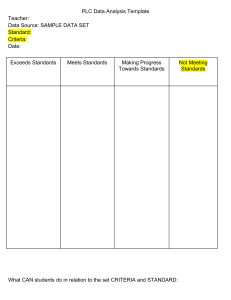
Arjuna JEE AIR (2024) SEQUENCE AND SERIES Q.1 Q.2 Q.3 Q.4 Q.5 Q.6 Three distinct A.P.'s have same first term, common differences as d1, d2, d3 and nth terms a 2b as an, bn, cn respectively such that 1 = 1 d1 d2 a 3 b7 3c = 1 . If 7 = then is equal to 7 c6 c6 d3 14 17 (1) (2) 49 21 40 13 (3) (4) 49 21 Let a1, a2, a3, ……, an are in A.P. such that 3 an = 100, a40 – a39 = then 15th term of A.P.. 5 from end is 448 452 (1) (2) 5 5 454 458 (3) (4) 5 5 2 Let , be the roots of ax + bx + c = 0 (a 0) and , be the roots of px2 + qx + r = 0 (p 0), and D1, D2 be the respective discriminants of these equations. If , , , are in A.P., then D1 : D2 equals a2 a2 (1) 2 (2) 2 p b 2 b c2 (3) 2 (4) 2 q r In a convex polygon, the degree measures of the interior angles form an arithmetic progression. If the smallest angle is 159° and the largest angle is 177°, then the number of sides in the polygon, is (1) 21 (2) 27 (3) 30 (4) 31 The first term of an A.P. is 5, the last is 45 and their sum is 400. If the number of terms is n and d is n the common difference, then is equal to d (1) 9 (2) 8 (3) 7 (4) 6 In an arithmetic progression, if Sn = n(5 + 3n) and tn = 32, then the value of n is [Note : Sn and tn denote the sum of first n terms and nth term of arithmetic progression respectively.] (1) 4 (2) 5 (3) 6 (4) 7 DPP - 01 Paragraph for questions nos. 7 to 9 Let the quantities 1, logy x, logz y and – 15 logx z be the first four terms of an arithmetical progression with common difference d. All terms of the A.P. being real. Q.7 The value of (xz–3 + xy + yz3) is equal to (1) 0 (2) 1 (3) 2 (4) 3 Q.8 Common difference d of the A.P. satisfies the equation (1) 6d3 + 11d2 + 6d – 16 = 0 (2) 6d3 + 11d2 – 6d – 16 = 0 (3) 6d3 + 11d2 + 6d + 16 = 0 (4) 6d3 + 11d2 – 6d + 16 = 0 Q.9 Magnitude of the sum of the first 25 terms of the A.P. is equal to (1) 575 (2) 675 (3) 625 (4) 552 Q.10 Positive integers a1, a2, a3, ........ form an A.P. If a1 = 10 and a a 2 100 , then (1) common difference of A.P. is equal to 6. (2) The value of a3 is equal to 20. (3) The value of a22 is equal to 136. (4) The value of a a 3 is equal to 820. Q.11 Let a1, a2, a3 ....... and b1, b2, b3 ...... be arithmetic progressions such that a1 = 25, b1 = 75 and a100 + b100 = 100. Then (1) the difference between successive terms in progression 'a' is opposite of the difference in progression 'b'. (2) an + bn = 100 for any n. (3) (a1 + b1), (a2 + b2), (a3 + b3), ....... are in A.P. 100 (4) (a r br ) = 10000 r 1 Q.12 Let 'p' and 'q' be roots of the equation x2 2x + A = 0, and let 'r' and 's' be the roots of the equation x2 18x + B = 0. If p < q < r < s are in arithmatic progression. Find the value of (A + B). ANSWER KEY Q.1 2 Q.7 4 Q.2 4 Q.8 3 Q.3 1 Q.9 1 Q.4 3 Q.10 1, 3 Q.5 4 Q.11 Q.6 2 Q.12 74 1, 2, 3, 4 PW Web/App - https://smart.link/7wwosivoicgd4 Library- https://smart.link/sdfez8ejd80if



